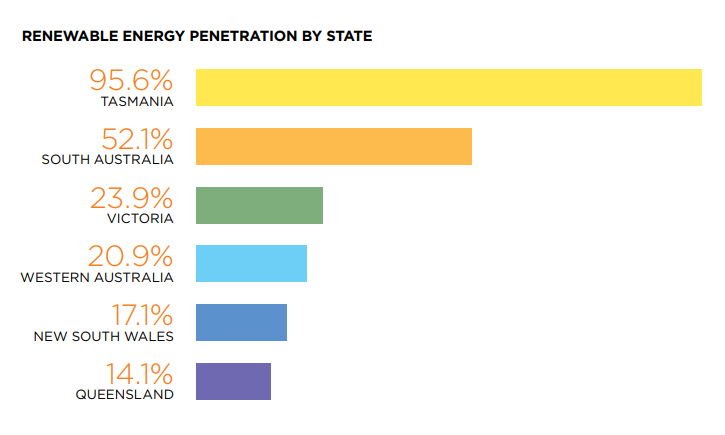Solar numbers are through the Roof! Sustainable Solar Electric Car Charging

Our great Steve Irwin said “I want the cleanest water, the freshest air and wildlife in abundance, but most of all I want a future for our children”. Renewable energy is emerging and slowly contributing to Australia’s total energy supply. Solar PV generated 24% of Australia’s electricity in 2018-2019, the majority came from small-scale rooftops. Over 2 million Australians, that’s over 21% of Australian households now have rooftop PV, with a combined capacity exceeding 10 GW. In addition, large-scale solar farms have increased in both production capacity and reached wide-scale operation in Australia. At the end of 2018, large scale solar farms generate over 1800 MW. The Australian Renewable Energy Agency forecast to install an additional 93 large scale farms. Electric Car charging stations are an important addition to solar to allow Australia to harness more clean energy.
Renewable energy penetration varies from state to state.
By connecting the latest research in Photovoltaic cells to key entrepreneurship players in the market – the solar industry will experience exponential growth. Coupled with effective solar energy rebates that cut the prices of solar. For a 6.6kW system to be installed in a residential house has a production cost of $7000, with government rebates consumers only have to pay $3300 that’s including the installation cost.
The small-scale solar juggernaut continued in 2019 with close to 80,000 installations alone in NSW. The number of accredited solar retailer programs grew by 313% as numerous government solar schemes made it mandatory for companies to participate in the solar movement. That’s a lot of energy and perfect for the homeowner looking to invest in solar electric car charging stations
With an ever-increasing interest by businesses and individuals towards renewables, the need for renewable energy sources is in dire need. On a large scale, over 90 projects were set under construction or financially committed at the end of 2019. While the future pipeline of energy is clogged due to policy uncertainty and transmission and connection challenges, the trend continues to rise in every shape and form
The general trend of increased solar installation and reduced costs will continue. All components in the PV system are drastically coming down in cost, it is 200 times less in real terms compared to the cost in 1978. It is estimated that the earth receives more than 170.000 terawatts of energy from the sun each year. Just to put it into perspective, the current consumption of earth is 10,000 times less than the earth receives. The real challenge is “how to harness this energy as effectively”. Using the Ocular IQ Solar you can use your electric car as a solar sponge to match your solar production.
The residential and commercial installations are increasing, with over 287,00 rooftops solar installations, at the same time due to reduced solar cost the average solar system size is increasing. With national average solar system size being 1.97kW in 2010 to 7.62kW in 2019. The positive impact that rooftop solar is having on the grid is apparent, the solar took the pressure off the grid during peak demands during the hottest days in Australia. This also allowed the EV Charger wholesale prices to remain at a sustainable and affordable price. The current potential of rooftop solar is capable of delivering over 179kW with an annual output of 245 Terra Wh, which is more than Australia’s current annual demand. We’ve got the potential which makes commercial electric car charging stations utilising solar so important. Why import oil when we can generate the electricity required for transportation.
Large scale solar projects are undertaking capital intensive solar farms. In Tenant Creek, Northern Territory, the $20 billion Sun cable project would involve a 10 GW solar distributed over 15,000 hectares of Australian dessert. To store the enormous amount of energy, a 22 GWh battery will be installed. In extension, the excess power will be exported to multiple overseas countries, precisely the transpacific trade agreement has committed for an undersea cable that will extend over 3800km. The project is underway but will speak volumes about trading electricity just like exporting goods. Despite the technological challenges, the project has been funded by high profile billionaires and while it is at the early stages, it will definitely be something to look out for.
Due to the high real-estate cost of land and as population numbers increase more individuals the land value seems to be increasing. Solar experts have been tremendously resourceful and starting using water as a surface to mount solar panels. Floating solar panel installation is spread around the world. Various water treatment plants have started to use floating solar. By covering the body of water, the plant encounters less treatment cost as it prevents any algae production as well as reduced water evaporation. Hydro-generation plans have started to incorporate similar design patterns to further the efficiency ratios.
The current solar installations are only limited to roofs, lands, and oceans. However future solar advancements will allow solar to become lighter, flexible, and available on all surfaces. Solar printing to solar paint, the possibilities are endless. It’s only a question of when. Will Solar be able to save us from our endless carbon-based fuels, the technology is currently on its way and the future is bright like the end of the tunnel.



